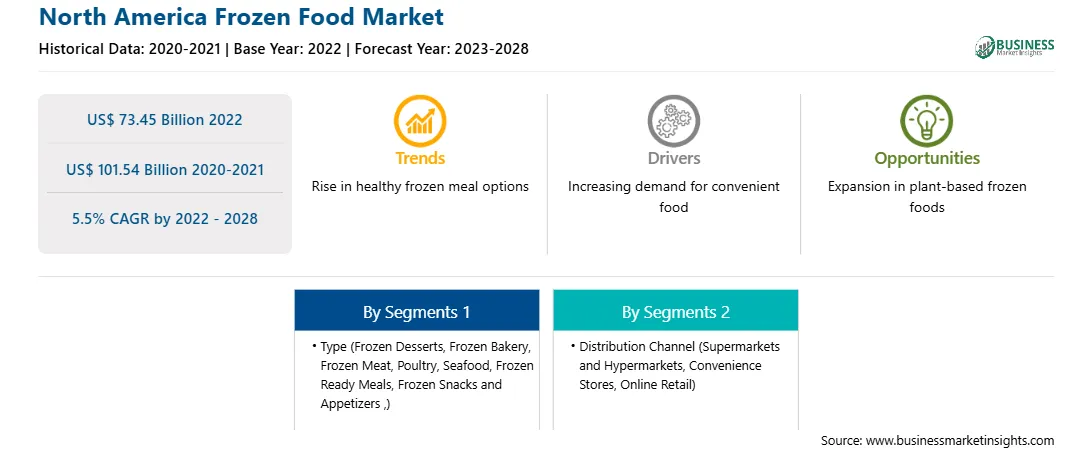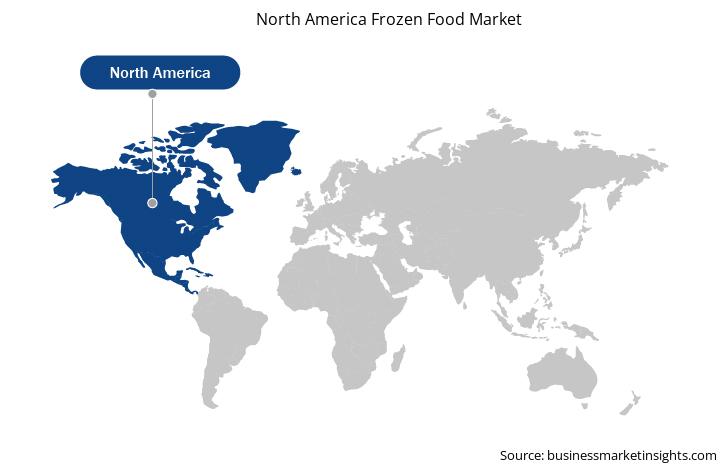The frozen food market in North America is expected to grow from US$ 73.45 billion in 2022 to US$ 101.54 billion by 2028; it is estimated to grow at a CAGR of 5.5% from 2022 to 2028.
The rising consumption of convenience food is a major factor driving the growth of the North America frozen food market. The lifestyles of people have evolved dramatically in the past few years. Due to hectic work schedules, people’s dependency on products saving time and effort has increased. A surge in the consumption of high-quality convenience food—including frozen snacks, frozen meals, cold cuts, and ready-to-eat products—is one of the biggest trends in the food industry. Convenience food allows consumers to save time and efforts associated with ingredient shopping, meal preparation and cooking, consumption, and post-meal cleaning and other activities. The development and popularity of these food items is also ascribed to the increasing number of smaller households and the rising millennial population across the world, among other social changes. Due to hectic work schedules, millennials tend to spend their money on convenience food. Moreover, according to data represented by the “International Labor Organization,” the female labor force across many countries has increased exponentially from 1990 to 2020, thereby adding to the popularity of convenience food, such as frozen food, among working-class populations. These factors are significantly boosting the frozen food market in North America.
The number of single or two-person households is growing in various developed countries, such as the US and Canada. According to the 2020 Current Population Survey, there were 36.1 billion single-person households in the US, accounting for 28% of all households. The growing number of one or two-person families can be related to the rising demand for ready-to-eat, convenience food. Frozen food products have extended shelf life and are available in sizes suitable for a single serve. Moreover, ready-to-cook frozen food can save time on food preparation. According to the “Power of Frozen” report published by the American Frozen Food Institute and Food Industry Association, frozen food sales in the US increased by 21% in 2020. Frozen breakfast products, including pancakes, waffles, and breakfast cereals, are also gaining huge traction among consumers.
North America Frozen Food
Market Revenue and Forecast to 2028 (US$ Billion)
Strategic insights for the North America Frozen Food provides data-driven analysis of the industry landscape, including current trends, key players, and regional nuances. These insights offer actionable recommendations, enabling readers to differentiate themselves from competitors by identifying untapped segments or developing unique value propositions. Leveraging data analytics, these insights help industry players anticipate the market shifts, whether investors, manufacturers, or other stakeholders. A future-oriented perspective is essential, helping stakeholders anticipate market shifts and position themselves for long-term success in this dynamic region. Ultimately, effective strategic insights empower readers to make informed decisions that drive profitability and achieve their business objectives within the market. The geographic scope of the North America Frozen Food refers to the specific areas in which a business operates and competes. Understanding local distinctions, such as diverse consumer preferences (e.g., demand for specific plug types or battery backup durations), varying economic conditions, and regulatory environments, is crucial for tailoring strategies to specific markets. Businesses can expand their reach by identifying underserved areas or adapting their offerings to meet local demands. A clear market focus allows for more effective resource allocation, targeted marketing campaigns, and better positioning against local competitors, ultimately driving growth in those targeted areas.North America Frozen Food Strategic Insights

North America Frozen Food Report Scope
Report Attribute
Details
Market size in 2022
US$ 73.45 Billion
Market Size by 2028
US$ 101.54 Billion
Global CAGR (2022 - 2028)
5.5%
Historical Data
2020-2021
Forecast period
2023-2028
Segments Covered
By Type
By Distribution Channel
Regions and Countries Covered
North America
Market leaders and key company profiles
North America Frozen Food Regional Insights

North America Frozen Food Market Segmentation
The North America frozen food market is segmented on the basis of type, distribution channel, and country. Based on type, the market is segmented into frozen desserts; frozen bakery; frozen meat, poultry, and seafood; frozen ready meals; frozen snacks and appetizers; and others. The meat, poultry, and seafood segment is expected to hold the largest market share during the forecast period. Based on distribution, the North America frozen food market is segmented into supermarkets and hypermarkets, convenience stores, online retail, and others. The online retail segment is projected to register the highest CAGR in the market due convenience associated with online buying and product delivery options. Based on country, the North America frozen food market is segmented into the US, Canada, and Mexico. The US held the largest market share in 2022.
Bellisio Foods, Inc.; Bonduelle Group; Conagra Brands, Inc.; General Mills; Kellogg’s Company; McCain Foods Limited; Nestle S.A.; Pepperidge Farm Incorporated; The Kraft Heinz Company; and Tyson Foods, Inc. are among the leading companies in the frozen food market in North America.
The North America Frozen Food Market is valued at US$ 73.45 Billion in 2022, it is projected to reach US$ 101.54 Billion by 2028.
As per our report North America Frozen Food Market, the market size is valued at US$ 73.45 Billion in 2022, projecting it to reach US$ 101.54 Billion by 2028. This translates to a CAGR of approximately 5.5% during the forecast period.
The North America Frozen Food Market report typically cover these key segments-
The historic period, base year, and forecast period can vary slightly depending on the specific market research report. However, for the North America Frozen Food Market report:
The North America Frozen Food Market is populated by several key players, each contributing to its growth and innovation. Some of the major players include:
The North America Frozen Food Market report is valuable for diverse stakeholders, including:
Essentially, anyone involved in or considering involvement in the North America Frozen Food Market value chain can benefit from the information contained in a comprehensive market report.